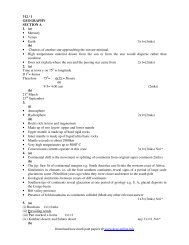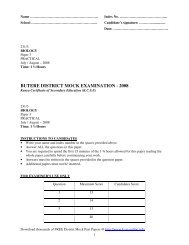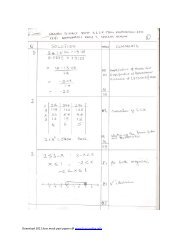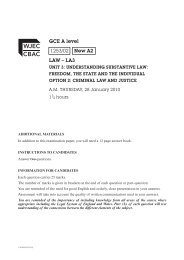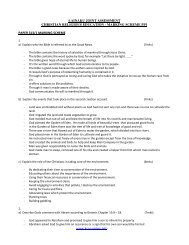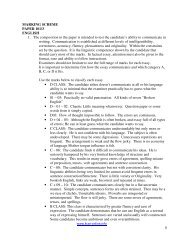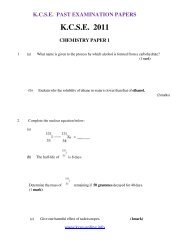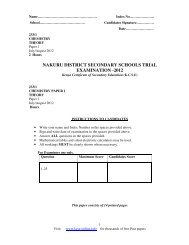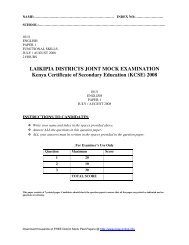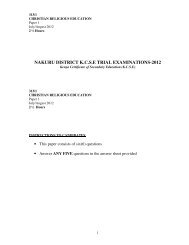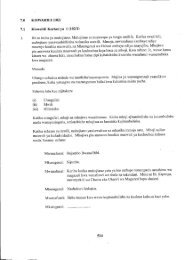2012 nakuru district mock biology ms paper 2.pdf - KCSE Online
2012 nakuru district mock biology ms paper 2.pdf - KCSE Online
2012 nakuru district mock biology ms paper 2.pdf - KCSE Online
- No tags were found...
You also want an ePaper? Increase the reach of your titles
YUMPU automatically turns print PDFs into web optimized ePapers that Google loves.
4. a) Incomplete dominance;b) BW X BW ;B W B W;BB BW BW WW ;Phenotytic ration1 black: 2 grey : 1 White1:2:1;c) Blood group;d) Colour blindness; reject colour blind5. i) Saprophytic bacteria break down organic mater; into simple soluble materials hence reductionof the organic matter;ii). Breakdown of organic matter by saprophytic bacteria result into release of nutrient ionshence an increase in concentration;iii) Saprophytic bacteria use up oxygen as they respire therefore a decrease in concentration ofoxygen; as the organic matter declines downstream, so does the activity of saprophyticbacteria hence dissolved oxygen increased concentration back to normal levels ;b) Fish population between the point of sewage discharge and the point where the organicmatter returns to normal levels, the population decreases drastically; due to lack of sufficientoxygen which is needed for respiration;c). Increased concentration of carbon (iv) oxide in the atmosphere;6. GraphScale X ;Y;Labeling X ;Y;;Plotting(2marks)Visit: www.kcse-online.info for 2 thousands of free Past <strong>paper</strong>s
Identifying of curves (1mk)Curves (1mk)b) O and 1 year;c) (i) 13 and 14 years;(ii) 12 and 13 years;d) (i) Increase in mass = 6.3 kgNumber of years = 3 yearsAverage increase = 6.3 = 2.1 kg;3ii) Increase in Mass= 16.1 kgNumber of years = 3 yearsAverage increase = 16.1 = 5.37kg;3e). Genotype ;Diet; hormones;f). Between 14-18 yrs is the age of puberty /adolescence; in boys androgens are secreted; whichstimulates development of secondary sexual characteristic which includes increased musclesdevelopment; girls do not secret androgens therefore less muscle development;.7. – The heart has atrioventicular valves (cuspidvalves); and semi lunar valves; allowing bloodflow in one direction only and prevent backflow.;- Valves have non-elastic chordae tendoneae preventing atriventricular valves fromturning inside out into auricles during ventricular systole.;- Has thick muscular walls which contract to pump and push blood;- Made up of cardiac muscle which are myogenic i.e contract and relax without gettingfatigue- SAN ; AND AVN; which initiate cardiac muscle impulse stimulating contraction ofatriac ventricles respectively.;- The heart reserved by vagus and sympathetic nerves which regulate the rate of heartbeat depending on body’s physiological/ requirements.;- Cardiac muscles served by coronary artery and coronary vein for supply of nutrients andO 2 and removal of wastes respectively;- Has specialized interconnected cardiac purkinje fibres which spread the wave ofexcitation throughout the heart muscles.;- Has four chambers which hold blood briefly before it is pumped to lungs and rest ofbody.- Has a septum wall preventing oxygenated blood on the left side of heart from mixingwith deoxygenated blood on the right side- Has vena cava and pulmonary vein that transport blood to heart auricles from rest of thebody and lungs respectively;Visit: www.kcse-online.info for 3 thousands of free Past <strong>paper</strong>s
- The pulmonary artery and aorta transport blood away from heart ventricles to lungs andrest of the body respectively;- Entire heart is enclosed by a tough double layered protective sac, the pericardium,preventing it from overstretching as it pumps.;- Pencandium secretor pericardial fluid lubricating it to reduce friction.;- Covered by a spongy fatty layer on pericardium protecting it by absorbing anymechawal shock;(20 marks)8. Comparative Anatomy/ Taxonomy;1. Members of a phylum/group show similarities ; organis<strong>ms</strong> have similar structures/ similarorgans performing the same functions eg. Digestive system, urinary system, nervoussystem;Pentadactyl limb (man hand, bat limb)- These are jormologons structures/organs whichperform different functions.;Analogous structures /different structures with different origin performing samefunctions/showing convergent evolution;2. Fossil records/paleontology;These are remains of organis<strong>ms</strong> preserved in naturally occurring materials for many years;show morphological charges of organis<strong>ms</strong> over a long period of time; eg skull of man (legof) horse;3. Comparative embryology;Vertebrate embroyos are (morphohgically) similar; suggesting the organis<strong>ms</strong> have acommon origin/ancestry;4. Geographical distribution;Present continents are thought to have been a large land mass joined together as a result ofcontinental drift ; isolation occurred bringing about different patterns of evolution;5. Comparative Serology/Physiology;Antigen-antibody reactions/rhesus factor, blood grouping /hemoglobin structure revealsome (phylogenetic) relationship among organism; showing common ancestry;6. Cell Biology/ Cytological;Occurrence of cell organelles eg mitochondria ribosome nucleus, cytochorones; point to acommon ancestry.Total 21 marks Max (20 marks)Visit: www.kcse-online.info for 4 thousands of free Past <strong>paper</strong>s
Visit: www.kcse-online.info for 5 thousands of free Past <strong>paper</strong>s



